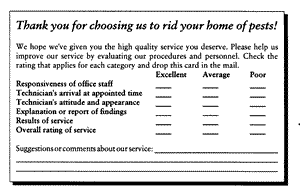How to Analyze Customer Complaints
There are three primary tools for analyzing complaints. The first is a general customer survey. This can be done by mail or phone.
 |
A prepaid post card can be sent or given to customers to solicit information about their perception of the service |
Some companies use a custom-designed post card, which can be given to customers by the technician after treatment, or mailed with statements, or sent with a cover letter to former customers. With prepaid postage and printing, the cards will probably cost about $350 per thousand, or 35 cents per card.
Other companies prefer the telephone. They call a small sample of customers and explain that they are trying to improve service. Ask them if there are any problems. What's working, what's not? Ask for suggestions for improvement. Conduct a similar survey every one or two years. If you can, try to sample the customers of your competitors, too. This will help you see how your competitors perform, and where you stand in comparison.
Another tool is to have a policy that technicians always tell management about complaints. A technician will often screen bad news, not wanting a supervisor to learn of a problem, especially if it involves his or her performance. Technicians have to believe that the complaint process is constructive, both for the company and for the technician.
But the primary tool for analyzing customer complaints is probably an effective customer complaint form. We have provided a sample one-page complaint form here: Complaint Form (PDF). The complaint form can be used by those taking complaints over the phone, or by technicians, or by supervisors. The form documents the complaint, and forces corrective action.
Someone should review complaint files periodically to be sure that every complaint was resolved, and to spot recurring problems and trends. Have both office and field staff, including technicians, read through the files occasionally. Use the files for training: How could we have prevented this service problem? How would you have handled it differently? Could we have responded better to the customer? Complaints should be considered not as an inconvenience, but as a tool to be used to improve service.
